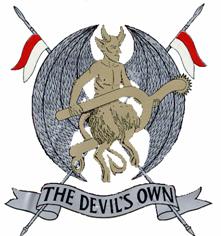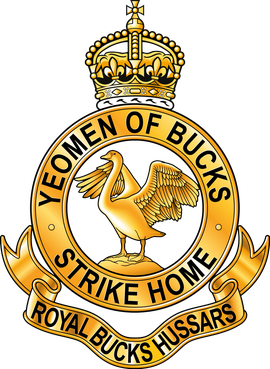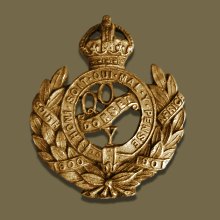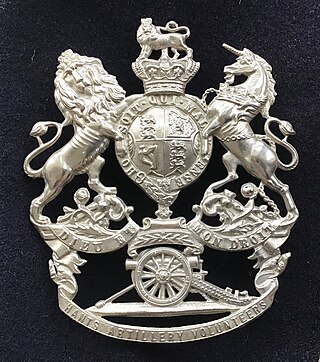
The Royal Gloucestershire, Berkshire and Wiltshire Regiment was a short-lived infantry regiment of the British Army.
The Rifle Volunteers was a regiment of the British Territorial Army. In 2007, it was re-designated as 6th Battalion, The Rifles.

The King's Own Royal Border Regiment was an infantry regiment of the British Army in existence from 1959 until 2006, and was part of the King's Division. It was formed at Barnard Castle on 1 October 1959 through the amalgamation of the King's Own Royal Regiment (Lancaster) and the Border Regiment.
The Rifles is an infantry regiment of the British Army. Formed in 2007, it consists of four Regular battalions and three Reserve battalions. Each Regular battalion of The Rifles was formerly an individual battalion of one of the two large regiments of the Light Division. Since formation, the regiment has been involved in combat operations in the later stages of the Iraq War and in the War in Afghanistan.

The 52nd Lowland Volunteers is a battalion in the British Army's Army Reserve or reserve force in the Scottish Lowlands, forming the 6th Battalion of the Royal Regiment of Scotland, also known as 6 SCOTS. Due to its erstwhile association with the 1st Regiment of Foot, it is the senior Reserve line infantry battalion in the British Army. It is one of two Reserve battalions in the Royal Regiment of Scotland, along with 51st Highland, a similar unit located in the Scottish Highlands.

The Inns of Court & City Yeomanry is a British Army unit formed through the amalgamation of The Inns of Court Regiment and The City of London Yeomanry in 1961. Its lineage is maintained by 68 Signal Squadron and the Band of the Royal Yeomanry.
The 130th Brigade, originally the Plymouth Brigade was an infantry formation of Britain's Volunteer Force, Territorial Force, and later Territorial Army (TA). In the First World War the brigade was in British India for most of the war and did not see service as a complete formation, but many of its battalions fought in the Middle East campaigns. The brigade did see action during the campaign in North West Europe of the Second World War, distinguishing itself at actions such as Operation Jupiter, the capture of Mont Pinçon, Operation Market Garden, at 'Dorset Wood' and at Hengelo. As 130 Brigade it continued in the postwar TA until 1961.
The 43rd Infantry Brigade was a brigade of the British Army during the First and Second World Wars, and later, as 43 (Wessex) Brigade, a regional headquarters from 1985 to 2014.

The Home Service Force (HSF) was a Home Guard type force established in the United Kingdom in 1982. Each HSF unit was placed with either a Regular Army or Territorial Army regiment or battalion for administrative purposes and given that formation's title, cap badge and recruited from volunteers aged 18–60 with previous British forces experience. It was introduced to guard key points and installations likely to be the target of enemy special forces and saboteurs, so releasing other units for mobile defence roles. It was stood down in 1992 due to budget cuts.

The Royal Buckinghamshire Yeomanry is an Operational Hygiene Squadron of the Royal Logistic Corps, originally formed as cavalry in 1794, and has also served in artillery and signals roles. The lineage is continued by 710 Operational Hygiene Squadron, Royal Logistic Corps.

The Queen's Own Dorset Yeomanry was a yeomanry regiment of the British Army founded in 1794 as the Dorsetshire Regiment of Volunteer Yeomanry Cavalry in response to the growing threat of invasion during the Napoleonic wars. It gained its first royal association in 1833 as The Princess Victoria's Regiment of Dorset Yeomanry Cavalry, and its second, in 1843, as the Queen's Own Regiment of Dorset Yeomanry Cavalry.
The West Somerset Yeomanry was a Yeomanry regiment of the British Army. First raised in 1794, it participated in the Second Boer War and World War I before being converted to an artillery regiment. It served in World War II. Post-war it was gradually reduced in strength until the yeomanry lineage of the successor unit was discontinued on 9 November 1988.

The 1st Wessex Artillery was a volunteer unit of the British Army that existed under various titles from 1860 to 1971, including active service in Mesopotamia in World War I and North Africa and Italy in World War II.
The Hampshire Brigade, previously the Portsmouth Brigade and later 128th (Hampshire) Brigade, was an infantry formation of the British Army of the Volunteer Force, Territorial Force (TF) and Territorial Army (TA) in existence from 1889 until after the Second World War. It served in British India during the First World War, but not as a complete formation. During the Second World War, the 128th Infantry Brigade fought in the Tunisia Campaign, in the Italian Campaign, and later in the Greek Civil War. The brigade was composed entirely of battalions from the Hampshire Regiment.

The Exeter & South Devon Volunteers was the premier unit of Britain's Volunteer Force. Formed in 1852 it went on to become a battalion of the Devonshire Regiment. Both its active service battalions went to garrison India on the outbreak of the First World War, and then saw action in Mesopotamia and Palestine. In the Second World War, the battalion served in the garrison of Gibraltar. It continued in the postwar Territorial Army until it was merged with other West Country units. Its successors today serve in a reserve battalion of The Rifles.
The 7th Battalion, The Rifles is an Army Reserve battalion of the British Army originally formed from elements of the Royal Rifle Volunteers, and Royal Green Jacket badged Sub-Units of The London Regiment following the Future Army Structure programme, and remains an integral part of the regiment.
The 3rd (Volunteer) Battalion, Staffordshire Regiment was a Territorial Army unit of the regular Staffordshire Regiment which was formed in 1988, but disbanded in 1999. The battalion's successor continues to serve in the Mercian Regiment to this day.
The Mercian Volunteers was a Territorial Army infantry regiment of the British Army, in existence from 1967 to 1988. Upon formation, it consisted of a singular battalion, however it later raised a second in 1975.
The Northumbrian Volunteers was a short-lived Territorial Army infantry regiment of the British Army, in existence from 1971 to 1975.
The Cleveland Army Cadet Force is the county cadet force for Cleveland that operates as part of the Army Cadet Force. Although the county of Cleveland was disestablished in 1996, the unit still maintains the name and recruits from its former area, which is now part of the North Riding of Yorkshire and Durham.








